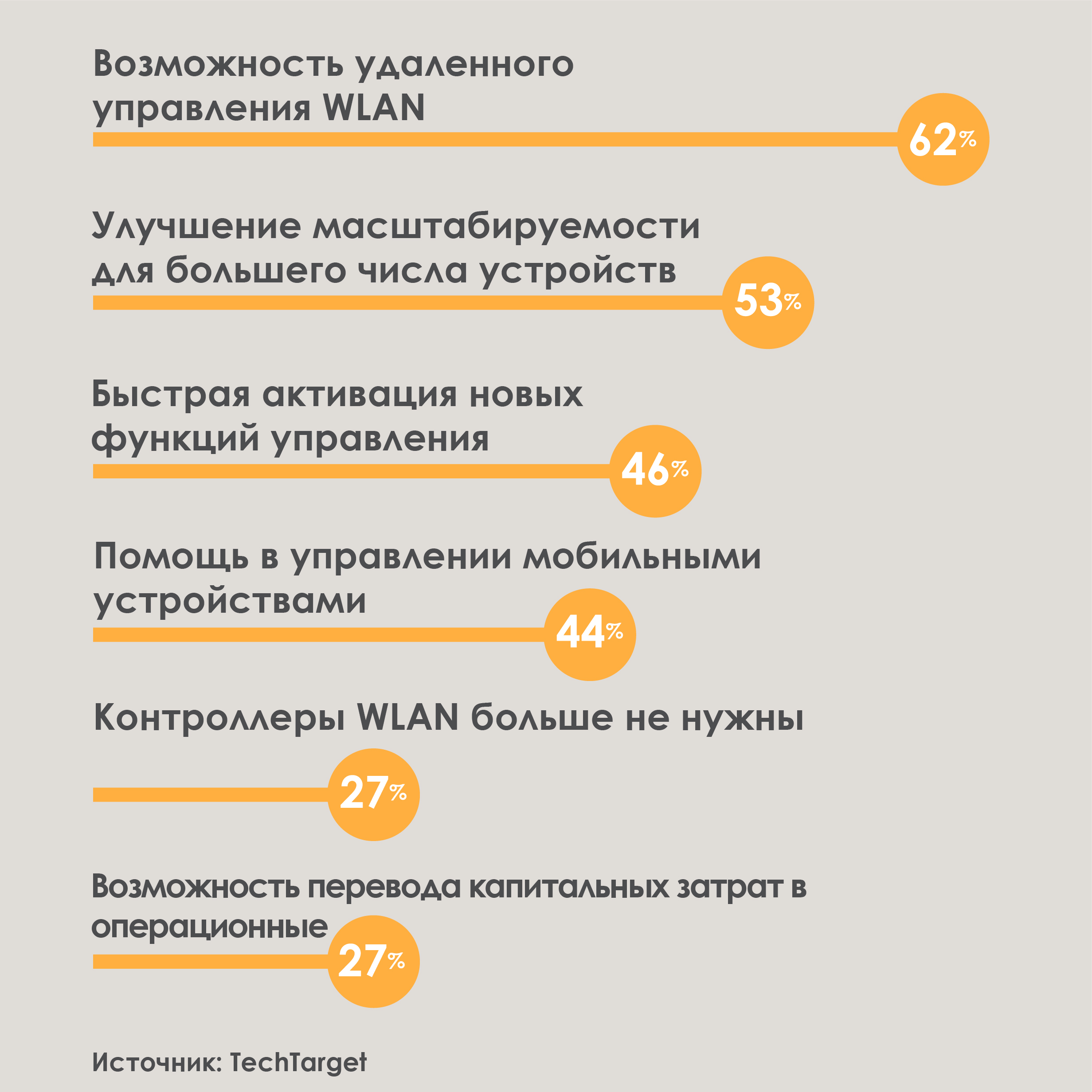Network administrator in the era of clouds

What will be the relevance of network administrators in the future? It is believed that cloud technology - "killer" network administrators. However, not everyone in the IT community shares this view. So what is the future for network administrators in 5-10 years? It all depends on the development of key technologies and models of corporate network management, such as CMN.
Cloud-Managed Networking (CMN) is an approach that attracts the attention of specialists thanks to an increasingly mature set of management functions and the growing recognition of cloud technologies in general. For example, in the wireless Wi-Fi segment of wireless networks, it is one of the fastest growing areas. According to IDC forecast, in the coming years it will grow by 35-40% annually. And this is not surprising - against the background of widespread penetration of clouds:

Clouds as a general trend: according to forecasts, by 2025 80% of corporate applications will go to the clouds, 80% of IT budgets will go to cloud services, only 20% of IT budgets will be spent on support and maintenance of systems. All corporate data will be stored in the cloud, application development will also go entirely into the clouds. And the clouds will be the safest place for IT operations. Source: Oracle.
Cloud management now offers more robust features, including wired and wireless network management. Functionally, these tools approach the traditional local network management platforms that are familiar to every admin.
')
What is cloud network management?
This is a way to remotely manage a company's network using cloud resources, rather than locally deployed controllers or management software. Like most cloud technologies, cloud network management is usually provided “as a service”. CMN uses the SaaS model and simplifies the management of local network devices such as wireless access points and switches.

Network devices can be configured and maintained using a cloud management platform. Its main purpose is centralized management and delegation of a part of corporate network management tasks to service partners — providers, reduction of operation and maintenance costs, rapid deployment and implementation of services in a distributed infrastructure.
Aerohive and Meraki were pioneers in cloud management of WLAN. Then Cisco, Aruba, Xirrus, HP, Motorola Solutions, Ruckus Wireless and a number of other vendors entered the game. Initially, “cloud Wi-Fi” was used mainly by small companies and organizations - with one office with few IT staff, but then this model became popular among larger organizations, such as retail chains, hotel chains, and educational institutions. They needed an effective alternative to the maintenance and administration of equipment in dozens of places where there is often no full-time IT staff.
This method allows you to manage all users and devices of the network centrally, from one place, which makes Cloud-based WLAN / LAN networks especially valuable for enterprises with a geographically distributed and branch structure.
Of course, a cloud-managed network is not a panacea, but in such organizations such a model is sometimes irreplaceable. Where there are no or no IT professionals, management from the cloud makes sense.
What are the benefits?
Network management from the cloud allows you to reduce capital and operating costs for the deployment and maintenance of the network. Administrators gain access to the control toolbar via the web interface from anywhere with an internet connection.
Such a cloud service can cover switches, wireless access points, and security gateways; it provides complete information for deploying devices, managing, monitoring, and diagnosing network problems.
When working with branch networks or in other situations where presence on the ground is impossible, the traditional form of management and troubleshooting may be untenable.
In CNM, problem solving and troubleshooting from anywhere becomes a reality. The administrator can receive a warning about the problem with the network, diagnose and eliminate it from any computer with Internet access. Thus, cloud management not only helps save time and resources, it opens up completely new opportunities that cannot be realized with legacy solutions.
Cloud management simplifies network deployment and expansion. Devices are configured by cloud providers, and when they are connected to a network, the configuration is loaded and launched automatically. The equipment is almost immediately ready for use.

Zyxel Nebula gateways can easily be deployed to remote sites automatically using a cloud. They automatically configure access policies and configuration settings, download from the cloud and install microcode and signature updates, eliminate the need for a network technician to be present on the site.
Simple scalability makes cloud-driven network infrastructure ideal for growing organizations with an ever-increasing number of users, devices, or branch offices.
In CMN, not only is there no need for trained IT staff at remote sites, you can more easily and quickly identify problems in the network, such as performance problems.
Since the majority of cloud-based network management services imply regular, predictable payments, companies do not need large initial costs, this model can provide long-term savings compared to traditional networks.
What awaits admins?
Among admins, there is an opinion that such systems can deprive them of work, and they are more beneficial for business owners, as they save money on payment for network / system administrators.
So will such systems be deprived of the work of system administrators or vice versa? What are the obvious advantages of such cloud services? Do clouds help increase productivity, reach goals faster, save money? Do administrators need to be afraid of the introduction of network clouds or adapt to them as the most modern trends and use the introduction of clouds to their advantage? Let's try to figure it out.
What, for example, attracts admins in the cloud-based wireless network management? Here is what the survey results show:

Answering the question of what attracts them most in cloud-based wireless network management, IT professionals call remote control capabilities (62%), rapid activation of new control functions (46%), help in managing mobile devices (44%). 27% like the fact that you can do without WLAN controllers, and the same number of respondents emphasize the ability of transferring capital expenditures to operational ones inherent to cloud services. Source: TechTarget.
That is, managing the network from the cloud is considered, first of all, as a convenient tool that helps the admin to do his job. And he gets quite specific results, for example:

This is how administrators who use cloud management tools (on the left) and those who do not use such tools (on the right) evaluate the performance of their networks. In the first case, 15% consider it optimal, 79% adequate, and only 6% inadequate. Source: Aberdeen Group.
Of course, not all administrators are inclined to use the cloud or any other third-party management service, preferring to manage their network independently, “keep everything under control”.
Meanwhile, cloud management reduces the load on network administrators and frees them from routine maintenance tasks. “I no longer need to worry about patches, about updating firmware. Now this is done through the cloud, so I always get the latest updates, ”so many admins could say.
Network administrators are not the only ones facing this dilemma today. The emergence of cloud-based "autonomous" DBMS, managed by artificial intelligence, has created fears that in the future database administrators will remain without work. However, experience has shown that everything is not so clear. According to experts, minimizing human labor reduces the number of errors, which makes it possible to improve the reliability of systems and reduce the cost of their maintenance.
“By removing part of the routine work with DBMS from IT professionals, we give people the chance to use the potential to create new systems and analyze data,” said Larry Ellison, CTO Oracle.
Thus, the emergence of such technologies can free people to work on higher-level tasks. This does not mean reducing the need for IT professionals, but suggests that the range of their tasks will constantly expand. In general, the conclusion is that in IT there will be more professionals who will work on a new range of tasks. Automation built into cloud solutions will free specialists from routine.
What about security?
Among the key benefits of cloud management of the corporate network (in particular, Wi-Fi) are usually called the ease of deployment and operation, as well as economic benefits. In recent years, many organizations have seen them in practice, but today one more consideration comes to the fore: security. Obviously, such features as prompt application of patches and firmware updates of network devices have a positive effect on network security, but how much can you trust the security of the cloud itself?

According to surveys, among the problems of cloud security continues to occupy the first place. It is considered a serious 29% of respondents. Source: RighrScale.
There are several aspects of cloud security. Software architecture and vendor engineering processes (software development lifecycle), focused on improving security, are key factors determining the internal security of cloud-based network management.
Physical security is usually at altitude. Network management applications are typically deployed in data centers of renowned cloud providers. Data center operators provide both physical protection of resources and their information security.
Cloud management allows administrators to get a real-time view of what is happening across the network, and more effectively provide protection against security threats.
It simplifies the configuration of the firewall and any security features for coordinated policy setup through a unified approach to configuring policies, allowing them to be applied to all security functions and automatically distributed to all network-connected security gateways.
DPI technology and the use of a malicious code signature database can eliminate the false positives of the protection system and help the admin provide effective protection against threats related to hidden vulnerabilities.
Security gateways can identify, classify, and control Web applications. Based on this information, administrators can block unauthorized applications and prevent them from using bandwidth. The latest security updates are applied automatically. This significantly reduces the load on the admin, ensuring high network security.
Since the procedures are automated, many factors that can lead to a security breach are eliminated, while due to errors in the “manual” configuration of the equipment and routine maintenance, vulnerabilities that could be exploited by intruders can be created.
In addition, traditional management is usually fragmented. It includes switch management, security, mobile device management, etc. Administrators must switch between different interfaces and deal with multiple support lines if they encounter problems.
In the case of a CMN, everything can be controlled using one management interface. This allows working in a new way with elements of the infrastructure. For example, administrators can view a complete network topology, updated in real time, and quickly fix problems with any network device. For secure communication with branch offices, you can quickly configure a VPN connection.
Cloud management provides administrators with extensive information about network performance, warning of problems. They can be diagnosed before they affect the network.
Do clouds have no alternative?
The flexibility and ease of use inherent in the management model from the cloud means much lower costs, and therefore the TCO is much lower than the traditional network infrastructure, often by a very significant amount.
At one time, command-line interfaces and manual configuration were sufficient to maintain network availability, but the old infrastructure could no longer keep up with the needs of modern organizations. CMN allows you to implement a promising, flexible network infrastructure that meets current and future requirements, improves efficiency and simplifies network management. Admin receives a complete picture of his network in a single web platform, regardless of where the devices are located. No need to go to a remote office to fix a network problem — you can do it from your workplace or even from home.
With CMN, organizations get a new model for building a network and providing services. Deployment of the network infrastructure takes place faster and with less labor costs, simplifies monitoring, increases flexibility, and consolidates management. So in fact, it is easier for the admin to control his farm.
Administrators are highly qualified specialists, however they are often busy with routine work, remain appendages of information systems. Certainly, automation and cloud services will not lead to the disappearance of administration. Most likely, the need for routine operations that do not require in-depth knowledge will disappear, and against this background qualification requirements will increase.
Source: https://habr.com/ru/post/429996/
All Articles